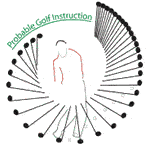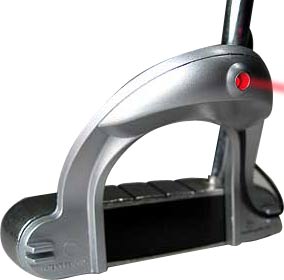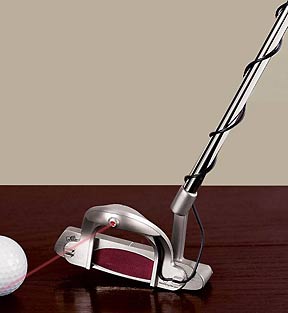Extreme Par 3 19th Hole 600 yd
The longest Par 3 Hole in the world is located in South Africa. It's called the Extreme 19th and is part of the experience playing at the Legend Golf and Safari Resort.
 |
As viewed with a zoom lens from the teeing area (photo left), the green is in the shape of Africa and apparently is contoured to replicate the elevation changes of the continent as well. The owners of the course cite some stats on their website which I would challenge as not being correct. Either they are exaggerating the facts or have made incorrect measurements. It's very easy to verify distances and elevations using Google Earth.
|
Here are my measurements of this Extreme 19th Hole: Vertical Drop from Tee to Green = 350 yd = 320 metres Horizontal Distance from Tee to Green = 508 yd = 466 m Distance from Tee to Green = 615 yd = 564 m |
 |
So, tee to green it plays about 615 yd yet you can hit the green in one shot, if you're a reasonably long hitter. Numerous professionals have played the hole; a number have birdied the hole. One accesses the tee via helicopter as it's quite a hike!
Below are golf ball trajectories for no wind, tailwind and headwind from a 110 mph driver club head speed (average PGA Tour). The location of the green is indicated by a horizontal, green line about 350 yd below the starting point.

The average PGA Tour player hitting Driver would likely land near the back of the green, if there was no wind (unlikely given the tee is so high from the top of a mountain). With a tailwind, such a player would need to club down a bit. With a headwind, most would likely not be able to reach the green and would land on the fairway.
Wind Effects on Club Range Variance
Most players, even golf professionals, underestimate the effects of the wind. This explains why average scores are significantly higher on days when it is quite windy. But just how much does the wind affect your trajectory? And, because your launch trajectory is not always the same (it has a certain degree of variability), the wind can increase your minimum and maximum carry distance with all clubs.
On windy days, players tend to be less confident in their ball striking and thus have more mishits. Many times these mishits cause launch trajectories that are a little higher than normal. Hit a ball higher into a head wind and the ball will be more greatly affected.
In a study of high level amateur players entitled, “SWING AND LAUNCH PARAMETERS IN APPROACH-IRON SHOTS HIT WITH VARYING HEIGHT AND TRAJECTORY IN GOLF,” by Samuel Robertson and Angus Burnett, a 2 to 3 degree variation in launch angles was observed. These variations resulted in a variation of carry and lateral distances.
I've produced the trajectories in the graphs below using my Tannar Golf Trajectory Software which I also use in my golf consulting business. Note the trajectories for an amateur golfer that is relatively long. Normally, a 7-iron carries about 169 yd (the black trajectory). In a 5 m/s (18 km/h or 11 mph) head wind has a huge effect on the trajectory. Note the blue trajectory of the 7-iron launched with the same launch angle of 23 degrees. The wind causes it to rise about 6 yd higher in flight and reduces the carry distance to about 145 yd (14 yd shorter), which is about a club and a half different.
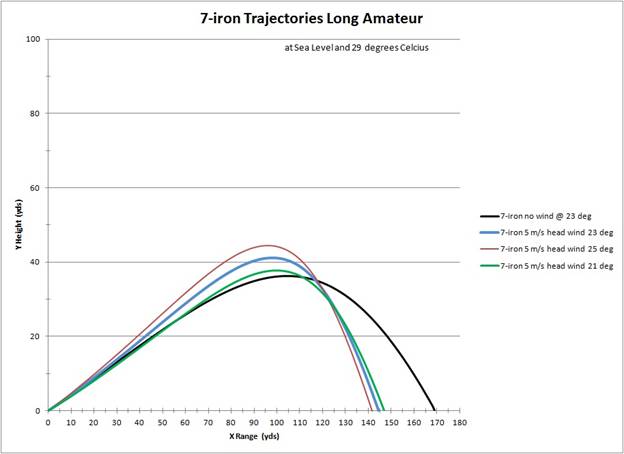
Now, let's say you hit the 7-iron on a slightly higher trajectory (say 2 degrees higher or 25 degrees). This trajectory is in red in the diagram. It flies about 10 yd higher than normal and ends up carrying only 142 yd. The green trajectory occurs with a launch angle of 21 degrees (2 degrees lower than normal). It carries about 147 yd. There is about a half club difference between mishitting low and high in this instance. And, this all assumes the same ball speed for all. Usually when you mishit a shot, the ball speed is lower and thus the carry distances are smaller.
In effect, the wind increases the variability of your mishits which leads to more missed greens and more penalty shots (due to hitting balls in hazards).
Below is are similar trajectories for PGA Tour pros (I used the Trackman data collected). Note that these players typically hit the ball lower, mainly due to the fact that they have descending angles of attack with irons shots which delofts the club. The wind causes a variability due to the wind of about 4 yd (143 yd carry to 147 yd carries). Slightly lower variability because of the lower trajectories.
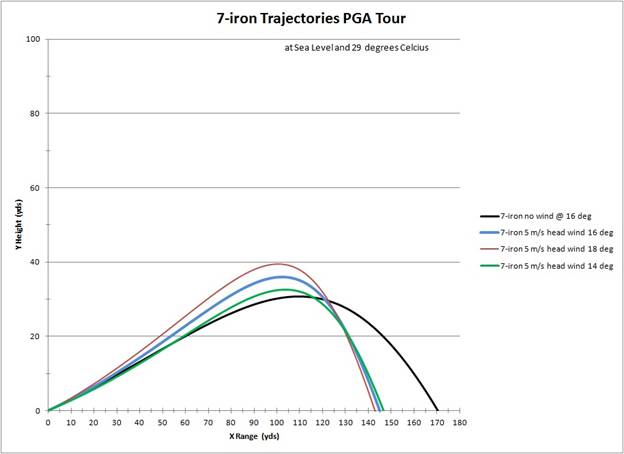
One Club Length, Different Lofts One length club, one set up, one swing, more consistency. Let the club do the work. Enter the code 10504 and receive free shipping, around the world, for a limited time, so act now! Learn more about these revolutionary clubs HERE. |
A 3-iron is only 2 inches longer than a 7-iron. For a typical golfer, the extra 2 inches in length results in an increase of only 3% in total length and thus only a 3% increase in club speed. But, a golfer that hits a 7-iron 150 yards will hit a 3-iron 190 yards, a 27% increase. What gives? The major determiner of distance next to club speed is club loft. Golfers hit their irons different distances because of their different lofts, not their different lengths. So, why are clubs different lengths? Mainly because of a misconception. |
In general, the higher the trajectory, the greater the effect of the wind on the carry distance, and the greater the variability due to the wind with mishits.
Players that are good wind players typically hit the ball lower than average (or have the ability to modify their swings to do so) and thus experience less variability in carry distances with their mishits.
So, what can the player do to decrease the launch trajectory so as to minimize the effects of the wind?
1. Learn how to hit the ball lower (hitting shots such as punch shots). This is difficult and requires changing the ball's position in your stance and swinging differently. Most amateur players haven't a hope in hitting the ball lower by changing their swing.
2. Use a club with lower loft than normal. You could have a full set of clubs that have say 2 to 4 degrees less loft compared to your normal clubs (your 7-iron would have a loft of 31 degrees instead of 35 degrees), but his would be very expensive. The alternative is to simply use a lower lofted club from your bag. If you normally carry your 7-iron 155 yds and need to play a shot into a headwind, then use a 6-iron or 5-iron. The actual amount depends on the speed of the wind.
I've developed a simple rule of thumb to use when playing the wind. It's a fairly simple process to estimate the speed of the wind and to get the general direction. You can then use my rule of thumb to know the effective carry distance compared to a normal shot (without wind). You then select the club to carry that new distance.
For instance, if your normal 7-iron carries 152 yd and you are playing into a 5 m/s headwind, that same 7-iron would only carry 128 yd. You would need to hit a club that would normally carry 175 yd to carry the 172 yd, most likely a 5-iron.
My little wind rule book explains how to easily measure the speed of the wind and then how much to adjust your carry distance (compared to normal) to hit your target. If you're playing a cross wind, I can tell you how much you need to aim left or right and then how far to carry, compared to normal.
Variability of Putting Distances & Club Carry Distances
Putting distance variability is greatly influenced by putter face contact with the ball. If the contact is high on the face, low on the face, left side or right side, one won't have solid contact and the ball won't have sufficient speed (unless you compensate by swinging harder).
Consistently ensuring contact with the ball and face are at the "sweet spot" of the putter is essiential to distance control.What is your variability in carry distance for your clubs? This variability is increased when playing in the wind, which means you're less likely to choose the correct club to hit your target.
 |
To the left is an image from Dave Pelz's Putting Bible showing the difference between the scatter of putter face contact for a Tour Pro compared to a 30 Handicap golfer. You can purchase some impression labels at this page: |
And, when the contact is left or right of the center, the putter face will twist open or closed causing an error in direction as well.
I really encourage you to practice this winter by simply trying to make solid contact with your putter. This will improve your distance control and your direction control.
Improve Your Putting with Phil Mickelson
Proper alignment can be learned. It can be mastered. You just need to know how you're aligning. You need a measuring tool to let you know.
Watch Phil Mickelson (one of the best putters on Tour) talk about putter face alignment.
You need a Laser Putting Alignment System. It'll help train your eyes, hands and arms to aim the putter face correctly.
You see, the initial direction of a putt is 85% dependent upon the face angle and only 15% dependent upon the path of the putter. So, cutting across the ball by about 6 degrees will have about the same effect as the putter face being closed by 1 degree.
Take a look at the Laser Putting Device that I use and consider getting one for yourself
Order yours TODAY! Regular Only $49.95 ..... Newsletter Members ONLY $34.95
What creates the variability in carry distance with the rest of your golf clubs? In the study of elite amateurs noted early, along with variable launch angles, there was also variable club speeds, face angle (open/closed), angle of attack and club path. One that was not measured, however, was club face contact position (contact position relative to the club's sweet spot). All of these variations result in golf ball trajectories and final shot results that vary, resulting in a scatter plot of end results. The better the golfer, the smaller the total area of the scatter plot.
I call this variation in end positions a golfer's “club print.” You can read more about this here: http://probablegolfinstruction.com/shot_patterns.htm
What each golfer needs to be aware of is the shape of their “club print” (how wide and deep it is). That way, the golfer can best estimate where to aim so as to increase the chances of getting the ball close to their target. For most amateurs, this usually means hitting one more club than normal, especially when there is trouble (water or bunker) short of the target. And, it usually means aiming left or right to compensate for tendencies to hit the ball right or left.
High and Low Trajectory Difference
One of the things that the best players practice is trajectory control and consistency. Hitting shot after shot so that they reach the same peak height. You'll recall from my last newsletter that for most golfers, the maximum height for each club is about the same: your 4-iron flies as high as your 9-iron. The 9-iron "appears" to fly higher because it reaches its maximum height soon and at a closer distance to the golfer.
Now, when you hitting balls, it's unlikely that the trajectories with any one club are consistent, even when you are hitting the ball well. For instance, say you are hitting 7-irons. You might be hitting the ball very solidly but some of the shots "seem" to fly signficantly higher than others, especially those that start right of your intended target (for a right swinger).
Those significantly higher shots are likely not that much higher at all. It's all a matter of your perspective again. Recall that a shot that appears to be higher is due to a steeper launch angle.
So lets say you're hitting 5-irons with an average launch angle of 15 degrees. You hit 4 in a row, solidly, and on almost the exact same trajectory at your target. Then, you hit one about 10 yards right of target (assuming you are a right swinger with a push) and it has a higher trajectory that "appears" to be significantly higher. A very plausible launch angle for such a shot is 17 degrees which is only 2 degrees higher.
But again, it's about perspective and comparison. Although your 17 deg shot is only 2 deg higher, relatively speaking, its 13% steeper (2/15 = 0.13). A 13% increase in launch angles "appears" to be a 13% increase in height, but in reality, it's not.
Below are the trajectories for an average PGA Tour 6-iron when it with a square clubface, a 2 degree open and a 2 degree closed clubface. Note that at 100 yards, the square face 6-iron ball is at an incline angle of 14 degrees while the 2 degree open ball is at 16 degrees, 2 degrees steeper (an increase of 14%). The golf ball heights, however, are 27 yards and 32 yards, respectively.

Cool Mornings -- Hot Afternoons
In the summer , we can have some major temperature changes between morning and afternoon, especially if you find yourself in a desert like region. Temperatures can be 50 to 60 degrees at dawn and then 100 to 110 degrees Fahrenheit by afternoon. Hotter temperatures mean the ball will fly farther (and roll farther) compared to the cool mornings. So, make sure you adjust by at least 1/2 club with your irons.
You can use my Golf Club Distance Temperature Calculator to calculate the exact effects.
Golf Group Combinations Optimized
I've created some templates for various combinations of groups. They are MS Excel worksheets.
For example, I've created optimized pairings for 12 Golfers playing between 4 and 12 rounds. Each spreadsheet allows you to input the names of your 12 Golfers and then sorts those into foursomes for each of the rounds. Each spreadsheet has a pairing matrix so that you can see how many times each player plays with each other player (in case there are some personality issues to sort).
I've also created a spreadsheet that computes pairings for a full range of golfers and rounds. Read more on this page.
For 12 Golfers |
Each spreadsheet includes: 1. Player Name Input Sheet (click here to see a sample) 2. Pairings Sheet which sorts the players into foursomes that minimize the number of repeats (click here to see a sample). 3. Pairing Matrix that identifies how many times each player plays in a foursome with each other player (click here to see a sample). |
GOLF TIP:
During the cooler wet season, play the forward tees to shorten the course.
This way, you'll be the same distance from the green as in the summer when
you play longer tees.
A tail wind won't increase the carry
distance much but increase the roll distance for an overall gain. The
greater the wind speed, the greater the gain. However, the higher the wind
speed, the more difficult it is to swing the club.










